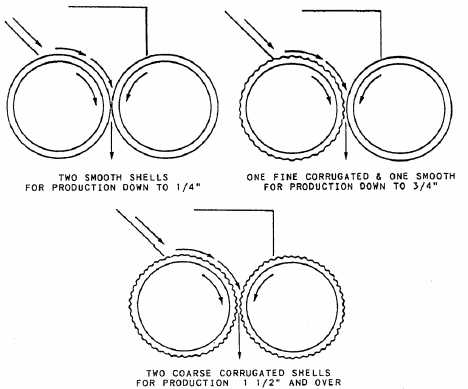spacing between the rolls. It is necessary
to
set
the
opening
between
the
rolls
slightly closer than the top product size
required.
With
two
coarse
corrugated
shells
(fig.
6-7),
the
tip-to-tip
setting
produces a product larger than two smooth
shells set at the same distance.
In the NCF, the hydrocone crusher is
normally used as the secondary unit. These
machines have a conical or domed crushing
member called a cone, head, or sphere,
which moves in a small circle around a
vertical
axis
inside
a
fixed
bowl
or
mantle.
The
cone
may
be
relatively
stationary at the top and move at the
bottom only, or be mounted so that the
head can wobble as well as gyrate. The
crushing head is free to turn under the
thrust from the material being crushed.
The fineness of the product is adjusted by
raising or lowering the mantle.
Effective
feed
and
discharge
arrangements
are
essential
to
the
operation of any cone type of crusher. For
maximum crushing efficiency, feed must be
supplied to the crushing chamber in the
optimum
amount
and
distributed
evenly
around the entire crushing area.
NOTE:
Material
received
by
the
hydrocone crusher must be evenly distributed
nonsegregated feed. This means that the
material
entering
the
crusher
is
evenly
distributed
around
the
entire
crushing
chamber, with fine and coarse material
well
intermixed
in
the
feed.
Unevenly
distributed
or
segregated
feed
results
in
poor
manganese
wear,
reduced
capacity,
and
high
stresses
within
the
crusher. These problems can cause short
bearing
life
and
possible
failure
of
major components. An evenly distributed,
nonsegregated
feed
results
in
maximum
capacity,
a
uniform
product,
and
a
smooth running machine.
A pressure gauge is standard on all
hydrocone crushers. Erratic hydroset control
pressure and motor amperage (horse-power
draw)
readings
are
evidence
of
poor
feeding
conditions
and
uneven
feed
distribution in the crushing chamber. The
pressure
gauge
enables
the
operator
to
read high, average, and low pressures in
the hydroset control and take corrective
measures against erratic and high-pressure
conditions. The pressure gauge should be
checked
regularly
when
the
crusher
is
receiving the full or maximum amount of
feed.
NOTE: When excessive fluctuations occur
in the pressure in the hydroset control and
horsepower drew, determine and eliminate the
cause immediately. Operating the crusher
under
these
conditions
can
cause
Figure 6-7.—Shell combinations for dual roll crushers.
6-6


